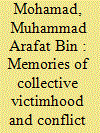|
|
|
Sort Order |
|
|
|
Items / Page
|
|
|
|
|
|
|
| Srl | Item |
| 1 |
ID:
160259


|
|
|
|
|
| Summary/Abstract |
Since regaining its independence in 2002, nation-building has been the focus of much scholarly research on Timor-Leste. National identity construction is a crucial aspect of this process, yet the ways in which this identity is officially represented has been largely overlooked. This article takes the national flag of Timor-Leste as a case study to explore the ways in which a historic East Timorese national identity has been symbolically constructed and visually embodied. By considering the potency of flags in an East Timorese cultural context, and by analysing the origins of Timor-Leste's flag alongside that of the political party Fretilin (Frente Revolucionária do Timor-Leste Independente), it becomes clear that post-independence re-imaginings of its symbolism have rendered it a powerful national symbol in the contemporary nation-state.
|
|
|
|
|
|
|
|
|
|
|
|
|
|
|
|
| 2 |
ID:
160257


|
|
|
|
|
| Summary/Abstract |
This article traces the changing relationships between the living and the dead in post-Khmer Rouge Cambodia. Fuelled with fear, confusion, and massive displacement, these relationships initially consisted of distrustful interactions. Over time, however, reciprocal relations of support were established, enabling a transformation of the dead from frightened and frightening beings, to benevolent allies in the reconstruction of post-Khmer Rouge Cambodia. These relationships allowed both the living and the dead to be brought in from the ‘forest’, thus showing how managing the dead was an integral aspect of post-conflict security. By comparing such relationships at Choeung Ek Genocidal Center (a national memorial site) and Koh Sap (an island in the Bassac River) this article shows how the dead replicate the locally situated politics of the living in these encounters.
|
|
|
|
|
|
|
|
|
|
|
|
|
|
|
|
| 3 |
ID:
160261


|
|
|
|
|
| Summary/Abstract |
This article assesses the interconnected nature of Southeast Asia around 1900, the transnational entertainment scene in Southeast Asia, and the role of Singapore as a hub for commerce, shipping, and entertainment. The global and regional development of transportation and communications technology and networks facilitated the movement of people, goods, ideas, and amusement forms. The article is based primarily on archival research from colonial newspapers in the region. It surveys and maps more than one hundred itinerant entertainment companies that travelled throughout Southeast Asia around the turn of the century, thereby creating and visualising a circuit of entertainment.
|
|
|
|
|
|
|
|
|
|
|
|
|
|
|
|
| 4 |
ID:
160258


|
|
|
|
|
| Summary/Abstract |
This article discusses the views and attitudes of the Malay-speaking Muslims of Thailand's Far South (henceforth, simply the Malays) about their collective position in Thai politics. Since 2004, the Far South, comprising the provinces of Narathiwat, Pattani, and Yala, has been engulfed in political violence that has claimed several thousand lives. Consequently, the conflict is often the subject of conversations among the Malays. More importantly, the Malays sometimes evoke their collective memory of episodes of past violence involving members of the Far South Malay society and the Thai state in their discussions about contemporary incidents. Why do the Malays hark back to the past when they discuss contemporary political violence? What connections do the Malays make between past and contemporary events? In this article, I discuss Malay collective memory about the Pattani Demonstration of 1975 and the Tomb of Martyrs at the Tok Ayoh Cemetery in Pattani province. I argue that, among the Malays, historic graves in Thailand's Far South are commemorative objects that aid the circulation of stories about collective victimhood pertaining to events such as the Pattani Demonstration. Such stories are central to the maintenance of a shared sense of community among the Malays vis-à-vis the rest of Thai society.
|
|
|
|
|
|
|
|
|
|
|
|
|
|
|
|
| 5 |
ID:
160260


|
|
|
|
|
| Summary/Abstract |
Reynaldo Ileto, in his classic Pasyon and Revolution, sought the categories of perception of the Filipino ‘masses’ that guided their participation in the Philippine Revolution. Among the sources he examined was the Carpio legend, which he unfortunately subsumed to the separate, elite Carpio awit (Tagalog poem). Through a detailed examination of the legend's historical and geographical context, with its invocation of two locations, Pamitinan and Tapusi, I arrive at a different understanding of lower-class consciousness than Ileto. Rather than a counter-rational expression of peasant millenarianism, the legend of Bernardo Carpio was a ‘hidden transcript’ celebrating the history of social banditry in the region.
|
|
|
|
|
|
|
|
|
|
|
|
|
|
|
|
| 6 |
ID:
160262


|
|
|
|
|
| Summary/Abstract |
This study grapples with two key puzzles: first, what happens when companies established as ethnic-based enterprises, including by migrants, are passed on to the next generation? Second, do these migrant businesses remain as ethnic enterprises after generational transitions? The empirical focus of this study is Malaysia, a country with one of the largest ethnic Indian populations outside India. To provide insights into these questions, this article pays particular attention to how an ethnic enterprise functions, in terms of types of goods and services produced and its targeted market, after the emergence of a new generation of owners with more class resources. The evidence from this study will provide insights into the validity of the concept of ethnic enterprise following a generational transition.
|
|
|
|
|
|
|
|
|
|
|
|
|
|
|
|
|
|
|
|
|